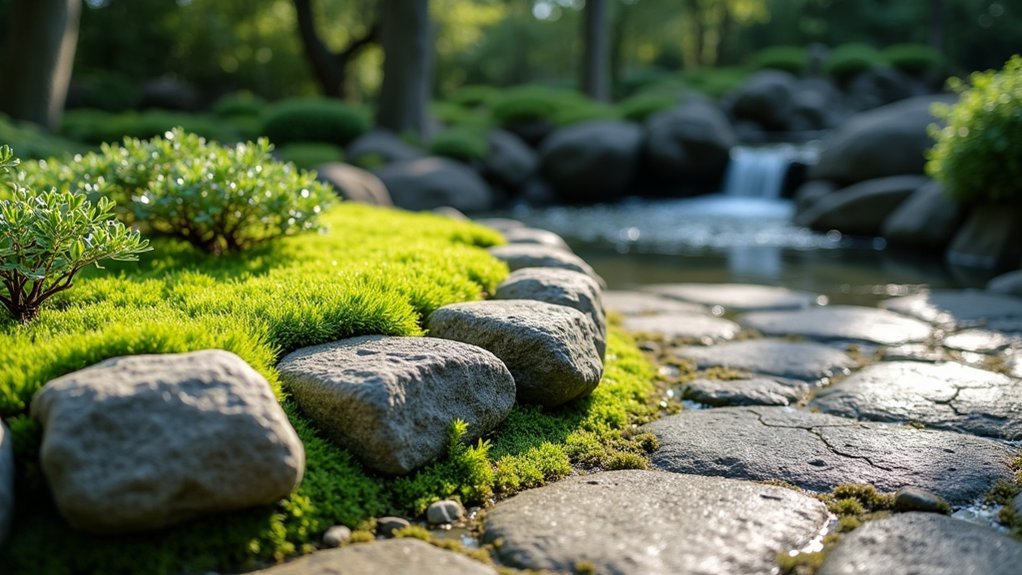Japanese stone-plant boundary mastery employs the “Miegakure” principle to create mystery through concealment and revelation. You’ll find stones arranged in odd-numbered groupings, avoiding symmetry for a natural appearance. Plants and moss soften changes while strategic layering creates depth perception. Position dominant stones at varying heights and use ground covers to integrate elements seamlessly. Consider seasonal changes when selecting plants to maintain year-round appeal. These techniques transform ordinary gardens into contemplative spaces that reveal their beauty gradually.
Traditional Principles of Stone-Plant Integration in Japanese Gardens

While examining Japanese gardens, you’ll notice that the integration of stones and plants follows the principle of “Miegakure”—a sophisticated technique that conceals and reveals garden elements to create mystery and depth.
The artful concealment in Japanese gardens invites discovery, as each turn reveals new beauty through deliberate design.
When setting stones, practitioners select specimens that represent natural forms, placing them in odd-numbered groupings for aesthetic harmony.
You’ll find these gardens intentionally avoid symmetry, instead achieving an organic composition where stones serve as focal points while complementary plants provide balance without overshadowing.
Ground covers like moss soften connections between hard and soft elements, reinforcing their natural integration.
This boundary mastery depends on understanding the relationship between elements—stones aren’t merely decorative but form the garden’s backbone, with plants strategically positioned to enhance rather than compete with their presence.
Creating Depth Through Layered Stone and Vegetation Boundaries
Depth perception in Japanese gardens relies on the strategic layering of stones and plants along carefully crafted boundaries.
When you position a dominant stone at varying heights surrounded by thoughtfully arranged vegetation, you’re practicing “Miegakure”—the art of concealing and revealing that adds depth to your garden space.
Arrange stones in odd-numbered groupings to create a more natural, organic appearance. This technique draws the eye across multiple planes, making even small spaces feel expansive.
The shift between stone and plant elements becomes most harmonious when softened with ground covers like moss.
Strategic Placement Techniques for Natural Flow and Balance

To achieve natural flow and balance in your garden, mastering strategic stone and plant placement becomes essential. The Japanese aesthetic often used in these boundaries relies on the “Miegakure” principle—creating moments of concealment and revelation that invite exploration.
Arrange stones in odd-numbered groupings to maintain natural balance, avoiding symmetry that disrupts the visual journey. Consider multiple viewing angles when positioning your elements.
| Technique | Purpose | Application |
|---|---|---|
| Odd-numbered groupings | Natural balance | Stone arrangements |
| Height variation | Visual depth | Plant selection |
| Miegakure principle | Mystery & exploration | Path design |
| Multi-angle viewing | Cohesive appearance | Overall layout |
| Earth tone palette | Unity & integration | Color selection |
Seasonal Considerations in Stone-Plant Border Design
Since Japanese gardens aim to capture nature’s ever-changing beauty, your stone-plant boundaries must account for all four seasons.
Previous owners of traditional Japanese gardens understood that seasonal shifts require thoughtful plant selection to maintain aesthetic appeal year-round.
In spring, integrate flowering specimens that highlight stone textures with vibrant blooms.
Summer calls for lush foliage plants that create invigorating contrast against rugged stone surfaces.
As autumn arrives, incorporate species with colorful changing leaves or decorative seed heads that complement the enduring quality of stone elements.
Winter presents unique challenges – select evergreen varieties that maintain structure when other plants recede.
This guarantees your stone-plant boundaries remain visually compelling even in dormant months, preserving the garden’s harmonious aesthetic appeal regardless of season.
Maintenance Practices for Sustained Boundary Harmony

While creating a stunning stone-plant boundary requires artistic vision, maintaining its harmony demands consistent, mindful care.
You’ll need to regularly prune at the stone-plant interface to preserve clean lines and prevent plants from overwhelming your garden’s focal points.
Implement a strategic layering approach with ground covers to soften shifts while still highlighting upright stones.
Ground covers create nature’s gentlest transitions, softening harsh boundaries while allowing sculptural stones to command attention.
Be certain you’re monitoring soil moisture at boundaries to prevent erosion that could destabilize your carefully placed elements.
Apply organic mulches around plants to suppress weeds and enhance visual integration between stone and vegetation.
Conduct seasonal inspections to assess stone placement integrity and make necessary adjustments.
This rhythmic maintenance cycle guarantees your Japanese stone-plant boundary remains balanced and visually striking throughout the changing seasons.
Frequently Asked Questions
What Are the 7 Principles of a Zen Garden?
The 7 principles of a Zen garden are simplicity, asymmetry, naturalness, symbolism, balance, harmony, and impermanence. You’ll create a contemplative space when you incorporate these elements into your minimalist garden design.
What Are the Four Elements of a Japanese Garden?
In Japanese gardens, you’ll find four essential elements: stones representing mountains, water features symbolizing purity, carefully selected plants showcasing seasonal beauty, and architecture like bridges and tea houses connecting you to nature.
What Are the Principles of Japanese Landscape Architecture?
You’ll find Japanese landscape architecture embraces harmony with nature, asymmetry, simplicity, and symbolism. It’s built on principles like miegakure (concealment), shakkei (borrowed scenery), and the thoughtful arrangement of stones in odd-numbered groupings.
What Are the Three Types of Japanese Gardens?
You’ll find three main Japanese garden types: Karesansui (dry landscape gardens with raked gravel), Tsukiyama (hillside gardens with artificial hills), and Chaniwa (tea gardens designed for the tea ceremony experience).
In Summary
You’ll find that Japanese stone-plant boundary methods aren’t just aesthetic choices, but spiritual practices connecting you to nature’s essence. As you implement these techniques, you’ll create gardens that shift and breathe through seasons while maintaining harmony. Master these principles of placement, layering, and maintenance, and you’ll develop spaces that transcend mere landscaping, achieving that distinctive tranquil boundary between human design and natural chaos.





Leave a Reply